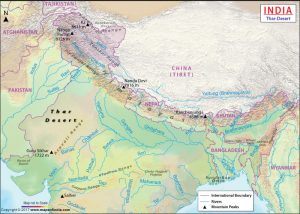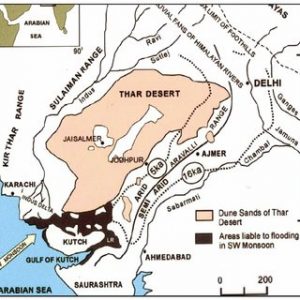From UPSC perspective, the following things are important :
Prelims level: Thar Desert, Desert National Park;
Mains level: NA

Why in the news?
Rajasthan’s barren Thar Desert may turn green, says a recent study in the journal Earth’s Future.
About Thar Desert
|

Why the thar desert getting greener?
- Climate Change Effects:
-
-
- Alteration of Weather Patterns: Climate change is causing shifts in rainfall distribution in the thar desert area.
- Potential for Vegetation Growth: The increased precipitation could provide favorable conditions for vegetation growth, contributing to the greening of the desert.
-
- Indian Monsoon Dynamics:
-
-
- Westward Extension of Indian Monsoon: The Indian monsoon, known for bringing heavy rainfall to eastern India, is now extending further westward into regions like the Thar Desert.
- Impact on Moisture and Rainfall: This change in monsoon dynamics could lead to increased moisture and rainfall in the desert region, facilitating the growth of vegetation.
-
- Expansion of Indian Ocean Warm Pool (IOWP):
-
-
- Influence on Monsoon Patterns: The Indian Ocean Warm Pool (IOWP) influences monsoon patterns and rainfall distribution over the Indian subcontinent.
- Westward Expansion due to Climate Change: Climate change is causing the IOWP to expand westward, potentially resulting in increased rainfall over semi-arid regions like the Thar Desert and promoting greening.
-
- Water Management Practices:
-
-
- Contribution to Greening: Effective water management practices, such as rainwater harvesting and irrigation techniques like johad, kuis, and kunds, may be playing a role in the greening of the Thar Desert.
- Utilization of Water Resources: By harnessing and efficiently utilizing available water resources, local communities and authorities can support vegetation growth and ecosystem restoration efforts in the desert.
-
- Introduction of Irrigation
-
- Commercial Cropping: Irrigation was introduced during British colonial rule in the 19th and 20th centuries to convert arid and semi-arid ecosystems into cropland.
- Restrictions on Grazing: The right to graze animals was restricted to landowners who cultivated crops, leading to the transformation of nomadic pastoralists into sedentary agropastoralists.
Sustainability of this transformation
|
| PYQ:
[2018] Which of the following leaf modifications occur(s) in the desert areas to inhibit water loss?
Select the correct answer using the code given below: (a) 2 and 3 only (b) 2 only (c) 3 only (d) 1, 2 and 3 [2020] The process of desertification does not have climate boundaries. Justify with examples. [2013] Major hot deserts in northern hemisphere are located between 20-30 degree north and on the western side of the continents. Why? |
Get an IAS/IPS ranker as your 1: 1 personal mentor for UPSC 2024
